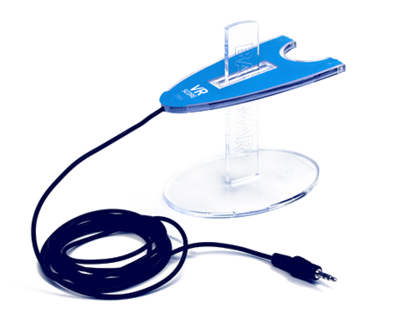VRTrek

| |
|---|---|
| Creator | Basemark |
| Requires | VRTrek Sensor Device, SDK |
| Precision | Less than 0.01 ms |
| Image | |
| Field of View | 12 degrees |
| Optics | |
| Sensors | 2 Photosensitive Sensors |
VRTrek, the virtual reality latency measurement device, is created by Basemark and now available for creators and developers. The VRTrek testing tool comes with necessary low-cost hardware and assistance solutions to measure and check the accuracy of the results. The testing package also comprises of the software development kit (SDK) to be used with the VRTrek Sensor Device.
Testing the Performance of the HMD[edit]
It looks like, every tech company, big and small, is under the virtual reality spell. Every other week, a new HMD or its related VR accessory like camera, headphone, controllers, etc., is announced or launched at some tech event. With so many VR HMDs finding its way into the hands of the consumers, it’s only natural to ask – How good are these virtual reality headsets?
To evaluate the performance of a virtual reality system, the current method adopted by most manufacturers involves testing the latency of the headset. Our brains are wired to pick up the slightest delays between the image that appears on the screen and our brain’s expectation. If both don’t sync, we feel nauseated. To measure the latency, virtual reality HMD makers now have a robust tool in the form of VRTrek. Basemark’s revolutionary tool will help manufacturers lay down virtual reality standards and design better-performing systems.
What’s in the Package?[edit]
The latency and performance measuring tool comprises of both the hardware (VRTrek), software (SDK), API Documentation, and User Guide. The software supports both DirectX 11 and 12. The hardware tool comes with optical sensors that are connected to the computer through the audio jack (microphone-in).
How Does the Tool Work?[edit]
The tool runs a series of tests on both the personal computer system and the VR HMD device. The Basemark tool supports OSVR’s HDK, Oculus Rift, and HTC Vive headsets. All along the development process, Basemark was working along with key industry players such as NVIDIA, Intel, and AMD.
System Test[edit]
The System Test checks the PC’s (Personal Computer) performance by running Sky Harbor on the system. The Sky Harbor virtual reality experience is developed by Crytek. The testing tool measures the frame rate and other crucial performance parameters throughout the test. The VR experience is run sequentially as fast as possible and the rendering sequence is repeated several times. The speed at which the rendering loop is completed determines the speed of the PC. The System Test only assesses the system performance and not the virtual reality headset. To measure the functioning of the VR HMD a full VRTrek test is needed.
VRTrek Test[edit]
This is the mode which has created so much buzz among the developers. The VRTrek Test will be using the key hardware component of Basemark. To run this test a hardware gadget with sensors will be used to assess the latency between images run using the personal computer and shown in the virtual reality headset. Similar to the above System Test, here too the tool runs a virtual reality experience again and again on the VR headset.
The latency of the headset is measured by the VRTrek device. The VRTrek gadget is a flat glass plate like structure with 2 photosensitive sensors. The flat plate is placed on a height adjustable stand. Adjust the height and position of the flat plate and make the sensors face the 2 lenses of the virtual reality headset. The cable, at the other end of the VRTrek device, is plugged in the computer’s microphone-in audio port.
The software uses the computer to direct flashes (of images) on the display of the VR HMD in a timely manner. The sensors on the VRTrek gadget pick up these flashes and send the analog measurements via the microphone-in port to the computer. The latency is determined by comparing the timing of the command and the display of the flashes on the headset. Apart from measuring the latency, the benchmark also detects duplicate frames, frame latency, and dropped frames that are received by the virtual reality headset. The tool also measures the latency of right and left eyes at the same time.
Specifications and Features[edit]
- VRTrek supports Windows 7 and newer. Windows Audio Kernel Mode Streaming is also supported.
- OLED display gadgets such as Smartphones, Virtual Reality HMDs, etc. are supported. On request LCD support is also offered.
- For virtual reality application measurements, the tool uses multi-frame latency measurement algorithm.
- For display latency measurements, single frame latency measurement algorithm is utilized.
- The testing tool uses PC’s audio jack (microphone-in) and RealTek integrated audio cards.
About the Company[edit]
Latency testing tool, VRTrek was introduced to the world by Basemark in March, 2016. The Helsinki based firm also made public the VRScore benchmark. Due to many delays, the release of the benchmark tool for the public was postponed a number of times. But, the corporate version of the VRTrek tool is ready and finding its way into the hands of developers and creators.
Basemark, the Helsinki based company, is already an established player in this field. It has introduced many well-known performance measurement tools and solutions. The pick of the pack is the Basemark X, which measures graphics performance of mobile gadgets.
Technical Specifications[edit]
| Parameter | Rating |
|---|---|
| Spectral Range of Sensitivity | Near infrared to deep blue / purple |
| Field of View | 12 degrees |
| Response Time | 8 microseconds |
| Accuracy | 0.2ms |
| Precision | Less than 0.01 ms |
References[edit]
2. https://www.basemark.com/products/vrtrek-library/
4. http://www.tomshardware.co.uk/basemark-vrtrek-library-latency-test,news-54434.html